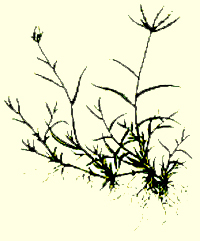 |
The Bay Gardener
By Dr. Frank Gouin
|
Stamp Out Bermuda Grass
With patience, you need no chemicals to beat this invasive
Bermuda grass, often called wiregrass, is a warm-season grass often referred to as the curse from the south. It is a difficult weed to control because it spreads by seeds, stolons and rhizomes. In July, August and September, each plant produces thousands of seeds that can remain alive in the soil for decades before germinating.
During the spring, summer and early fall months, it also spreads by above-ground stems called stolons and underground creamy white stems called rhizomes. Both of these will sprout new plants as they extend above or beneath the soil. In loose sandy soils, the rhizomes can often be found six to eight inches deep. The tips of the rhizomes are as sharp as needles.
Attack Bermuda grass in its two weak spots: First, it cannot grow in shade. Second, it goes dormant soon after the first frost in the fall. If you are patient, you can almost rid your lawn of Bermuda grass.
First, adjust your lawn mower to cut the grass three and a half to four inches tall. This will encourage the blue grasses and fescues, both cool-season grasses, to grow. With time, these cool-season grasses will shade out the Bermuda grass.
However, you must also make certain that the soil under your turf has a pH of near 6.5 and that you only fertilize your lawn in the fall and never in the spring or summer.
Blue grasses and fescues absorb most of their nutrients when soils are cool in fall and winter months. Bermuda grass absorbs most of its nutrients when the soils are warm during spring and summer months. By fertilizing only in the fall, you are favoring the cool-season grasses while starving the Bermuda grass. Top-dressing your lawn in the fall with compost and top-seeding with bluegrass and fescue blends of lawn seed will hasten competition between the two grasses. Keeping the lawn mower setting high will also help crowd out the dandelions, plantain and crabgrass.
Bermuda grass in Zoysia
Q Over the last few years, patches of wild Bermuda grass have appeared in my dense, 10-year-old Meyer Zoysia lawn. How did it get there, and how do I get rid of it without killing the zoysia?
—Tom Ronaldi, Southern Anne Arundel County
A No chemical will kill Bermuda grass without killing Zoysia. What you will have to do is spray the infested area in mid-July with Roundup. To get a complete kill, do not mow the grass for at least a week before and after you spray. After mowing, allow it to grow a second time for a week before making a second application. Use Roundup at the recommended concentration. Allow at least three weeks to pass before you plug the Zosia back into the killed area. You can remove plugs from your existing lawn where there is no Bermuda grass growing.
Grow the Best Sweet Corn You’ve Ever Tasted: Step 2
When your corn plants are knee high, fertilize with a high nitrogen fertilizer such as 10-6-4.
Step 1 appeared in the paper of May 25. Look for more steps when the time is ripe.
Ask Dr. Gouin your questions at [email protected]. All questions will appear in Bay Weekly. Please include your name and address.